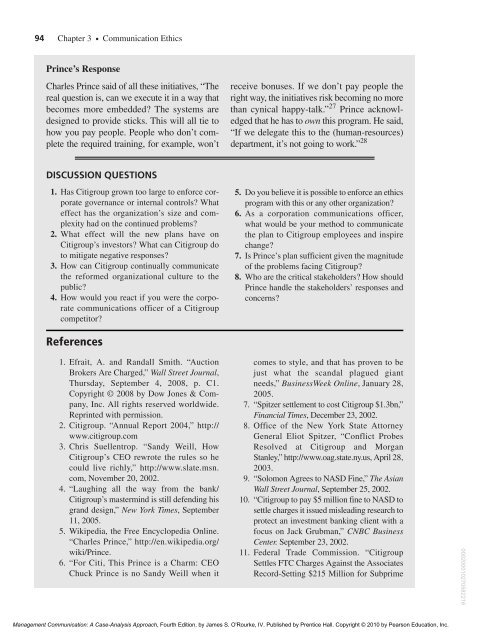MANAGEMENT COMMUNICATION - Pearson Learning Solutions
MANAGEMENT COMMUNICATION - Pearson Learning Solutions
MANAGEMENT COMMUNICATION - Pearson Learning Solutions
You also want an ePaper? Increase the reach of your titles
YUMPU automatically turns print PDFs into web optimized ePapers that Google loves.
94 Chapter 3 ● Communication EthicsPrince’s ResponseCharles Prince said of all these initiatives, “Thereal question is, can we execute it in a way thatbecomes more embedded? The systems aredesigned to provide sticks. This will all tie tohow you pay people. People who don’t completethe required training, for example, won’treceive bonuses. If we don’t pay people theright way, the initiatives risk becoming no morethan cynical happy-talk.” 27 Prince acknowledgedthat he has to own this program. He said,“If we delegate this to the (human-resources)department, it’s not going to work.” 28DISCUSSION QUESTIONS1. Has Citigroup grown too large to enforce corporategovernance or internal controls? Whateffect has the organization’s size and complexityhad on the continued problems?2. What effect will the new plans have onCitigroup’s investors? What can Citigroup doto mitigate negative responses?3. How can Citigroup continually communicatethe reformed organizational culture to thepublic?4. How would you react if you were the corporatecommunications officer of a Citigroupcompetitor?5. Do you believe it is possible to enforce an ethicsprogram with this or any other organization?6. As a corporation communications officer,what would be your method to communicatethe plan to Citigroup employees and inspirechange?7. Is Prince’s plan sufficient given the magnitudeof the problems facing Citigroup?8. Who are the critical stakeholders? How shouldPrince handle the stakeholders’ responses andconcerns?References1. Efrait, A. and Randall Smith. “AuctionBrokers Are Charged,” Wall Street Journal,Thursday, September 4, 2008, p. C1.Copyright © 2008 by Dow Jones & Company,Inc. All rights reserved worldwide.Reprinted with permission.2. Citigroup. “Annual Report 2004,” http://www.citigroup.com3. Chris Suellentrop. “Sandy Weill, HowCitigroup’s CEO rewrote the rules so hecould live richly,” http://www.slate.msn.com, November 20, 2002.4. “Laughing all the way from the bank/Citigroup’s mastermind is still defending hisgrand design,” New York Times, September11, 2005.5. Wikipedia, the Free Encyclopedia Online.“Charles Prince,” http://en.wikipedia.org/wiki/Prince.6. “For Citi, This Prince is a Charm: CEOChuck Prince is no Sandy Weill when itcomes to style, and that has proven to bejust what the scandal plagued giantneeds,” BusinessWeek Online, January 28,2005.7. “Spitzer settlement to cost Citigroup $1.3bn,”Financial Times, December 23, 2002.8. Office of the New York State AttorneyGeneral Eliot Spitzer, “Conflict ProbesResolved at Citigroup and MorganStanley,” http://www.oag.state.ny.us, April 28,2003.9. “Solomon Agrees to NASD Fine,” The AsianWall Street Journal, September 25, 2002.10. “Citigroup to pay $5 million fine to NASD tosettle charges it issued misleading research toprotect an investment banking client with afocus on Jack Grubman,” CNBC BusinessCenter. September 23, 2002.11. Federal Trade Commission. “CitigroupSettles FTC Charges Against the AssociatesRecord-Setting $215 Million for Subprime000200010270582216Management Communication: A Case-Analysis Approach, Fourth Edition, by James S. O'Rourke, IV. Published by Prentice Hall. Copyright © 2010 by <strong>Pearson</strong> Education, Inc.

















